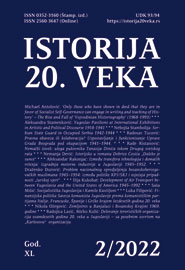YUGOSLAV PAVILIONS AT INTERNATIONAL EXHIBITIONS IN ARTISTIC AND POLITICAL DISCOURSE 1918–1941
YUGOSLAV PAVILIONS AT INTERNATIONAL EXHIBITIONS IN ARTISTIC AND POLITICAL DISCOURSE 1918–1941
Author(s): Aleksandra StamenkovićSubject(s): Interwar Period (1920 - 1939)
Published by: Institut za savremenu istoriju, Beograd
Keywords: National Pavilions; International Exhibitions; King Alexander I of Yugoslavia (Karadjordjević); The Yugoslav Idea
Summary/Abstract: Exploring the context of constructing the Yugoslav national pavilions at international exhibitions in the period between the Two World Wars implies the analysis of the used architectural styles, also certain political ideologies that find their expression in architecture (thus lending it a role of social engagement). The parallel flows of socio-political discourses and architecture also require resolving the following dilemma: was the architect selected based on his or her education, sensibility and experience for a particular project, or forced to conform to the demands of the political authorities. The heritage, status of the nation, the architect, furthermore numerous social, cultural and, above all, political factors influence the variations in the art programs showcased in the pavilions. One such factor – the ideal of cultural connection and political cooperation among the South Slavs, supported by King Alexander Karadjordjević – plays an important role in defining the program and stylistic characteristics of the pavilions because it suggests a specific artistic expression. Attempts to develop this ideal into the ideology of Yugoslavism, that in certain respects sought to establish itself as the national identity, marked the period between 1918 and 1941. Such attempts represented both a prerequisite and a directive in the representative programs of the Kingdom of Serbs, Croats and Slovenes/Kingdom of Yugoslavia.
Journal: Istorija 20. veka
- Issue Year: 2022
- Issue No: 2
- Page Range: 301-322
- Page Count: 22
- Language: English

